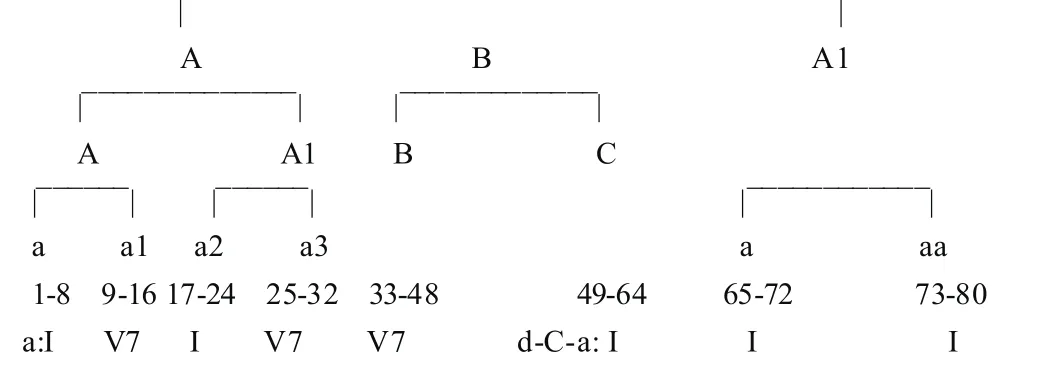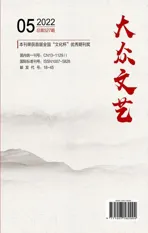Astor piazzolla and his new Tango
2011-10-25青岛大学音乐学院山东青岛266000
王 正 (青岛大学音乐学院 山东青岛 266000)
Astor piazzolla and his new Tango
王 正 (青岛大学音乐学院 山东青岛 266000)
Abstract:this project focuses on the history of the tango and the biography of one of the greatest exponents of Argentine Tango, Astor piazzolla. The project concludes with a musical analysis of piazzolla’s:Libertango. The analysis surveys the areas of form,melody,rhythm,and texture.
Keyword: Tango, Originate, Music
1.Origins of the Tango
The origins of the Tango are unelear,as with many aspects of folk culture,experts do not agree on the subject.A number of investigations conducted by Tango musicologists reveal different influences on this musical genre directly related to the etymology of its name.Popular belief indicates that through hybridization,four dances have contributed to the formation of the Tango,namely:
(1)The Candombe:
This is a group dance of African origin,imported to Argentina from Montevideo,Uruguay,towards the end of the nineteenth century.
(2)The Milonga:
The Milonga was the traditional dance of the native.It originated as a vocal song accompanied by guitar in 2/4 tempo,similar to the tango,but with a softer,less jarring feel.In the 1800s,gauchos would gather together to sing and dance the Milonga after a long day of hard labor from transporting goods between Buenos Aires and the provinces.
(3)The tango andaluz:
In the eighteenth century,the Spanish city of Andalucia produced a species of popular dance able song called ‘‘Tango”.
(4)The Habanera:
This Cuban dance appeared as a derivation of the Spanish, itself a stylization of the English“country—dance”,and it was cultivated in the suburbs of La Habana.
2.Development of the Tango
(1)Early Development(1980-1912)
The birth of the Tango took place during the mid—nineteenth century in Buenos Aires,a big cosmopolitan and multicultural urban center with half of the city occupied by mostly male immigrants from Spain,Italy,Syria,Lebanon,Israel,Russia,and central European countries.
(2)Interim Development(1913-1930)
In this time, The Tango became a new vehicle for the expression of thoughts and feelings,simultaneously opening doors to future possibilities for both Tango poets and singers It was the favorite instrumental as well as vocal music of the cabaret,due to the performances of more melodic and temperate Tangos given by the Orquestas Tipicas of Roberto Firpo,Francisco Canaro and Juan Carlos Cobitin.
(3)Tango Renaissance(1930-1950)
From the last years of the 1920s and beginning of the 1930s,its status suffered an abmpt decline Many factors coincided to create this phenomenon. But fortunately,this decade ended with the first recovery of the Tango’s fame,made possible by the development of mass media communication in the form of radio and sound motion picture by the decade of the 40s,radio stations created new idols of radio—theater,and musicals(the most common type of films at the time)were based on topics related to the Tango,employing actors who were Tango singers.The 40s is considered to be the golden decade of Tango history.
4Analytical Study of Astor piazzolla’s Tango:Libertango
About the work analysis ,structure graphical representation:

There are two main section separated by tempo contrast.this in a common feature in some of piazzolla’s works:a two-part division consists of one section that is melodic and slow,and a contrasting B section,that depends on constant rhythmic motion.
Part A(1-32): consist of A and A1
A(1-16):a(1-8)+a1(9-16), rhythmic chords which served to induce a lively atmosphere and rhythmic interest,and sustained chord that are reserved predominantly for the right hand.
In the majority of the right hand’s passages,Piazzolla explores the subdivision of common tine in uneven groups of eighth notes,with emphasis on the first,fourth,and seventh eighth notes,resulting in the characteristic Piazzollean 3+3+2 rhythmic organization.The incorporation of this rhythm into tango is one of Piazzolla’s signature innovations. Piazzolla’s normal method of indicating irregular accentuation is to use accent(>)marks.

From the previously mentioned 3+3+2 accenting pattern,he derives another one that’s even moreelaborated and innovative.It consists of the grouping of notes,forming four groups of three notes each and ending with two proups of two,thus giving birth to the 3+3+3+3+2+2 pattern.
The approach that Piazzolla took in this piece retains tango elements,with the addition of an enriched harmony through the employment of chromatic progressions.This can be seen on the left hand.

These are ornamental ascending or descending scales,p;ayed just before the beat,usually in the lower register. These scales resemble the quick slides produced. This harmonic preference for chromaticism,which he used until the end of his composing career,clearly shows an eminent jazz influence in his music.
Bibliography:
[1] Carlos Kuri: Piazzolla: la música límite. Buenos Aires: Corregidor,1997.
[2]Piazzolla, Ástor. A manera de memorias, Libros Perfil 1998, ISBN 9500809206, p. 85
[3]Piazzolla, Ástor. A Memoir, Natalio Gorin, Amadaeus, 2001,pp. 70-1
[4]The Evolution of the tango and astor piazzolla’s tango nuevo ,I-Ching tsai,Claremont Graduate University,2005.
王正,青岛大学音乐学院西方音乐史硕士。
